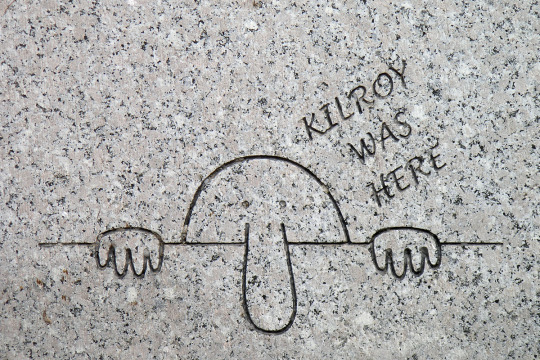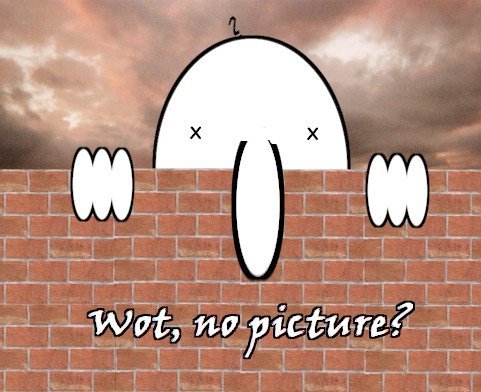Text
It’s ya boy: Kilroy.

Photo credit: Luis Rubio from Alexandria, VA, USA - Kilroy was here, CC BY 2.0, https://commons.wikimedia.org/w/index.php?curid=3558598
As you can see, Kilroy has visited the World War II memorial in Washington D.C. This iconic drawing answers many questions about itself. Who made this? Kilroy did. Why did he make this? To leave a record of where he was. Where has this fella been? More like, where hasn’t he been? Have you seen the places this graffiti shows up?
But there remain two questions that are not answered by the typical depiction of Kilroy: where did he come from, and where did he go and what was his rhetorical function? Well, I may be the only one asking that latter one, but I digress.
Kilroy: Origins
Kilroy, as we understand him today, came about during the second world war. His exact origins are unknown, but he has an intellectual lineage that can be traced back to 1938 or 1941, depending on which origin story you like more.
The first of his intellectual progenitors is known as Mr. Chad, or just Chad. Chad is a figure whose origins are as shrouded as Kilroy’s. Just like Kilroy, he is a bald (or mostly bald) man peeking over a wall with an abnormally long nose.

Mr. Chad with a version of his catchphrase and a single hair. [source]
There are two prevalent theories on how Chad came into being. The first of them involves a British cartoonist named George Edward Chatterton. Supposedly, Chatterton drew the original back in 1938, and his nickname “Chat” went on to become the name of the drawing “Chad”. [source]
Another story claims that Chad was spawned around the year of 1941 by a lecturer in a school in Gainsborough, Lincolnshire. While illustrating the affect of a capacitor in a circuit, the phrase “wot, no electrons” was added to a portion of the drawing that resembled a face.

[source]
There are other variations on that story, featuring electricians and/or military engineers adding “wot, no ___?” to illustrations like the one above. Unfortunately, none of these stories (at least in my mind) really explains why Chad became used widely amongst the military, especially when one considers that shortages and rationing (the things Chad typically complained about) would have affected civilians approximately as much as it did the military.
Regardless of where it came from, this simple design would go on to become Kilroy’s body. The accompanying phrase, however, is even more difficult to pin down. This is due mostly to the fact that “___ was here” is an extremely generic phrase to find graffitied. . . well anywhere really. Fortunately, there is a probable origin of the phrase! In December of 1946, the New York Times attempted to get to the bottom of the phrase’s origin. After holding an event to determine who came up with Kilroy, they landed on James J. Kilroy, a welding inspector who worked in the Bethlehem Steel shipyard in Quincy, Massachusetts. Welding inspectors used a small chalk mark to approve a piece of work. But, that was easily erased by welders so they might be paid twice for their work. Purportedly, Mr. Kilroy decided to mark his inspections with the phrase “Kilroy was here” with a material that was more difficult to erase. This lead to the phrase being discovered in sealed spaces on ships, the kind of spaces that no one had been before. That lead to a competition among US airmen to reach obscure and otherwise out-of-the-way locations before Kilroy could. [source]
Another theory involves a Sergeant Francis J. Kilroy Jr. In this story, Sgt. Francis wrote “Kilroy will be here next week” on a barracks builtin board, to inform his fellows of his imminent return after a run in with the flu. This prompted the phrase to be picked up and spread by other US airmen. [source]
The common nature of the phrase “Kilroy was here” combined with the easily recreated drawing known as “Mr. Chad” and gave birth to a graffiti phenomenon that lasted for decades.
Now before I move on I want to give an honorable mention to Australia’s “Foo was here”. Foo was a graffiti character in much the same vein as Chad and Kilroy. He was also a head that tended to peek over walls, though his nose was of a much more reasonable size. Foo was accompanied by the phrase “Foo was here”. Unlike Kilroy and Chad, Foo dates all the way back to the first world war, and was a creation that followed the First Australian Imperial Force. Foo evolved over the years and by the time WWII came around he was depicted as a gremlin or a devil often within (or having escaped from) a cage. It is also worth noting that unlike the previous stories, there is nothing that can directly tie Foo to Kilroy or Chad. [source]
Kilroy: Functions
Kilroy had many functions over the years. He let military servicemen know where their comrades had been before. Hiding his visage in the most obscure of locations must have been a humorous pastime for some people. But the function of Kilroy that I wish to discuss is his use as a panopticon.
First things first though. What the hell is a panopticon? Without getting too far into it, the concept of a panopticon is this: an object, person, or event that instills in its viewer a sense of being watched, typically in such a way that they mediate or otherwise alter their own actions. A simple example would be a teacher when their students are taking a test. The mere presence of a teacher may be enough to prevent people from attempting to cheat. The implication of authority is also important to panopticons, if you know your best friend is watching you, you likely wouldn’t alter your behavior too much, if at all; if you know a police officer is watching you, you may be less inclined to smoke weed, go over the speed limit, or even jaywalk. If you wish to go a bit more in depth on panopticons you may do so here.
Allow me to start this part by saying that not every Kilroy is a panopticon. Even the ones that are, aren’t to every viewer. Simply put, the groups that spread Kilroy’s image need never worry that the he is watching them. To a certain extent, anyone who draws Kilroy is Kilroy. And since the people who drew him are English speaking (mostly US) military servicemen, and the citizenry they serve, anyone outside of those groups observing Kilroy may see the watchful eyes of the US staring at them.
To share an example of dubious authenticity, picture yourself in the year of 1945. Germany has surrendered and you and the Allied leaders, Churchill and Truman, are going to decide the fate of Germany (after the Krauts started and lost their second world war). As you may have already guessed, you are Stalin: the leader of the Russian people and a ruthless dictator. You have arrived in Potsdam, and are ready to discuss terms with your allies. Upon arriving, you are given a brief tour of the facilities from which you will negotiate. Your guide finally arrives at the grand VIP bathroom, an opulent room befitting one of your status. The guide encourages you to go in without him, for even he is not allowed inside. You take a moment to relieve yourself; the journey here was a long one. You return to the guide and complete the tour. Hours pass. You have completed the first round of talks with your allies, and all the water you drank to sooth your parched throat has come back to haunt you. You return to the bathroom you visited previously in the day, and use the exact same toilet you used last time. As the tight squeeze on your bladder lifts, you notice something that wasn’t there before. A small man with a large nose is peeking at you from over a wall, with the English phrase “Kilroy was here” written next to him. Your knowledge of the English language is limited, but you know enough to say with certainty that an English speaking individual named Kilroy had been in your VIP bathroom. Fury clouds your mind as you somehow manage to keep everything in the toilet bowl. If Kilroy had been here, where only you and the two other VIPs were allowed, where else could this man have been? What else could he have seen? As you leave the bathroom, you use the time spent washing your hands to calm your mind. Perhaps this was someone your aides know about. You return to the conference room, where the translator for the English speakers still resides. Your presence brings your aides to full attention, and you ask them (in Russian) “Who is Kilroy?”. [source, take it with a grain of salt] [also, here is a source that says Stalin had a decent grasp on the English language]
That dramatization of events that may or may not have happened illustrates Kilroy’s use as a panopticon. Once Stalin got context on who Kilroy was, he may have concluded that his actions at Potsdam had more spectators than he anticipated. Which may have then lead him to acting differently than he would have otherwise. Even if it didn’t happen, the fact that it is a story that was told speaks to how others could see his use as a panopticon.
Another story that is even less likely to be true is one involving Hitler. Allegedly German soldiers had found the phrase “Kilroy was here” written on captured US equipment. Hitler, in his infinite paranoia, decided that it could be the name of an American spy. [”source”]
Whether or not either of these stories are true they illustrate how Kilroy is capable of operating as a panopticon.
In conclusion:
We came into this asking hard questions, that kind that couldn’t be answered just by looking at the average depiction of Kilroy. We learned that this iconic piece of American history (probably) came from distinctive British Graffiti, and an American welding inspector. We then briefly considered Foo, before promptly forgetting about him. We finished with Kilroy being more than just a humorous piece of graffiti, and instead saw him act as the eyes of authority: a panopticon. This simple drawing went on to become more than the sum of his parts, and has been immortalized not just on the WWII memorial in Washington D.C., but also in the hearts and souls of all those who carry on his legacy.
1 note
·
View note